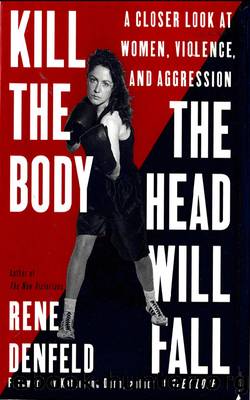Kill the Body, the Head Will Fall by Rene Denfeld

Author:Rene Denfeld [DENFELD, RENE]
Language: eng
Format: epub
ISBN: 9780446570022
Publisher: Grand Central Publishing
Published: 2009-11-29T00:00:00+00:00
Eight
THE POWER OF FEAR
There are posters on the gym walls, which Jess pointed out one day. They are of his best-known fighter, Adofo Akil, when his name was still Mike Colbert. He fought against Marvelous Marvin Hagler for the middleweight title. Colbert, who now sits on the Oregon Boxing Commission, still shows up at local amateur fights.
When Jess tells the story about Colbertâs title shot against Hagler, he laughs and shakes his head. Colbert was ahead on the cards when, at the end of the eleventh roundâsome say after the bell rangâHagler broke his jaw.
Colbert could have stopped the fight because of the injury, and perhaps won it on a technical foul. But instead, he returned to his corner, kept quiet about the injury, and went back out in the twelfth round to continue fighting.
All Hagler had to do was watch for his chance. He broke the other side. Jess says you could just see the hinges of Colbertâs jaw fall open and the blood gush out. He went down like a sack of potatoes, and Jess says it took awhile before he forgave his boxer for risking a career-ending injury.
But he tells the story with secret pride. Colbert had heart.
* * * *
The image of the boxer rising to meet his opponent again, injured and racked with pain, invigorates as it repels. I can see all too vividly the broken hinges of Colbertâs jaw. It amazes me how he continued to fight while experiencing such pain.
How little fear he must have had. Or how well he mastered his fear. What heart he had, to fight back.
For a lot of women, the idea of fighting back when injured, to walk into your opponentâs blows knowing you will get hurt, is foreign, nearly unimaginable.
Ours is a society that makes it hard for women to defend themselves. The same socialization that may make us less likely to commit crime also appears to make us more fearfulâin negative, debilitating ways.
In the course of researching this book, whenever I told someone its subject was women and aggression, the person invariably thought I meant women as victims.
But most crime victims are men, preyed upon by other men. Over three times as many men as women are murdered every year, and thousands more are victimized in muggings, shootings, robberies, and assaults.
In fact, women and the elderly are the two groups least likely to be victimized by crime. If you are a white woman over the age of sixty, you win the bonus prize: Your chances of being the victim of a violent crime are substantially less than just about everyone elseâs. Yet it is women and the elderly who fear crime the most, a situation some have termed âthe paradox of fear.â 1
Professor Mark Warr is an expert on the subject of fear and crime, and he has published groundbreaking studies on the subject. I called him at the University of Texas at Austin, where he teaches sociology.
Warr told me he has found that in general peopleâs fear corresponds closely to the likelihood of victimization.
Download
This site does not store any files on its server. We only index and link to content provided by other sites. Please contact the content providers to delete copyright contents if any and email us, we'll remove relevant links or contents immediately.
Nudge - Improving Decisions about Health, Wealth, and Happiness by Thaler Sunstein(7255)
iGen by Jean M. Twenge(5166)
The Fire Next Time by James Baldwin(5024)
Adulting by Kelly Williams Brown(4239)
The Hacking of the American Mind by Robert H. Lustig(4092)
The Sports Rules Book by Human Kinetics(4079)
The Ethical Slut by Janet W. Hardy(4042)
Captivate by Vanessa Van Edwards(3732)
Mummy Knew by Lisa James(3522)
In a Sunburned Country by Bill Bryson(3374)
The Worm at the Core by Sheldon Solomon(3327)
Ants Among Elephants by Sujatha Gidla(3282)
Suicide: A Study in Sociology by Emile Durkheim(2908)
The Slow Fix: Solve Problems, Work Smarter, and Live Better In a World Addicted to Speed by Carl Honore(2843)
The 48 laws of power by Robert Greene & Joost Elffers(2816)
Humans of New York by Brandon Stanton(2690)
Handbook of Forensic Sociology and Psychology by Stephen J. Morewitz & Mark L. Goldstein(2605)
The Happy Hooker by Xaviera Hollander(2586)
The Tipping Point by Malcolm Gladwell(2563)
